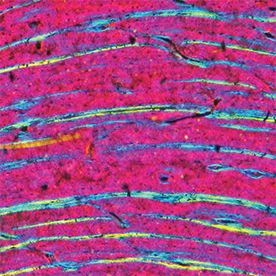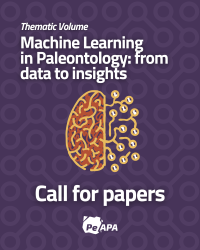A BASIC GUIDE FOR SAMPLING AND PREPARATION OF EXTANT AND FOSSIL BONES FOR HISTOLOGICAL STUDIES
DOI:
https://doi.org/10.5710/PEAPA.07.04.2020.314Keywords:
Paleohistology, Technique, Thin section, ProtocolAbstract
The study of bone microstructure of fossil vertebrates (i.e. paleohistology) has demonstrated to be a very important source of paleobiological information. Paleohistological studies are based on the standardized analysis of petrographic thin sections. Although the development of new technologies (e.g. microtomography) have provided non-destructive procedures for the study the fossil tissues, thin sections are still the main information source in paleohistology. In this contribution, we provide a detailed protocol for sampling and thin sectioning preparation of bone tissue from both fossil and extant vertebrates. We describe the most common procedures for sample obtainment and also some particular differences, which are related to variations in the equipment and sampling techniques. The main objective of this contribution is to offer an alternative protocol for laboratories in formation and/or with limited funding.
References
Chinsamy, A. 1990.Physiological implications of the bone histology of Syntarsus rhodesiensis (Saurischia; Theropoda). Paleontologia Africana 27: 77-82.
Chinsamy, A. 1993. Bone Histology and growth trajectory of the prosauropod dinosaur Massospondylus carinatus Owen. Modern Geology 18: 319-329.
Chinsamy, A. 1995. Ontogenetic changes in the bone histology of the Late Jurassic ornithopod Dryosaurus lettowvorbecki. Journal of Vertebrate Paleontology 15:96-104.
Chinsamy, A. andRaath, M.A. 1992. Preparation of fossil bone for histological examination. Palaeontologia Africana 29:39-44
Company, J. 2011. Bone histology of the titanosaur Lirainosaurus astibiae (Dinosauria: Sauropoda) from the Latest Cretaceous of Spain. Naturwissenschaften 98: 67-78.
Curry, K.A. 1999. Ontogenetic histology of Apatosaurus (Dinosauria: Sauropoda): new insights on growth rates and longevity. Journal of Vertebrate Paleontology 19:654-665.
Dupret, V., Sanchez, S., Goujetc, D., Tafforeaub, P. and Ahlberg, P.E. 2010. Bone vascularization and growth in placoderms (Vertebrata): The example of the premedian plate of Romundinastellina Ørvig, 1975. Compets Rendus Palevol 9: 369-375.
Enlow, D.H. and Brown, S.O. 1956. A comparative histological study of fossil and recent bone tissue. Part I. Texas Journal of Science 8: 405-443.
Erickson, G.M., Curry-Roger, K. and Yerby, S.A.2001. Dinosaurian growth patterns and avian rapid growth rates. Nature 412: 429-433.
Erickson, G.M., Curry-Rogers, K., Varrichio, D.J., Norell, M.A. and Xu, X. 2007. Growth patterns in brooding dinosaurs reveals the timing of sexual maturity in non-avian dinosaurs and genesis of the avian condition. Biology Letters 3: 558-561.
Hayashi, S., Carpenter, K. and Suzuki, D. 2009. Different growth patter between the skeleton and osteoderms of Stegosaurus (Ornithischia: Thyreophora). Journal of Vertebrate Paleontology 29: 123-131.
Klein, N. and Sander, P.M. 2007. Bone histology and growth of the prosauropod dinosaur Plateosaurus engelhardti Von Meyer, 1837 from the Norian bone beds of Trossingen (Germany) and Frick (Switzerland). Special Papers in Palaeontology 77: 169-206.
Klein, N. and Sander, P.M. 2008. Ontogenetic stages in the long bone histology of sauropod dinosaurs. Paleobiology 34: 247-263.
Lamm, E.T. 2013. Chapter 4 - Preparation and Sectioning of Specimens. In: Padian, K. and Lamm, E.T. (Eds), Bone Histology of Fossil Tetrapods: Advancing Methods, Analysis and Interpretation. University of California Press, Berkeley, p. 55-160.
Lee, A.H. and Werning, S. 2008. Sexual maturity in growing dinosaurs does not fit reptilian growth models. PNAS 105: 582-587.
Lehman, T.M. and Woodward, H.N. 2008. Modeling growth rates for sauropod dinosaurs. Paleobiology 24: 624-281.
Luna, C.A., Cerda, I.A., Zurita, A.E., Gonzalez, R., Prieto, M.C., Mothé, D. and Avilla, L.S. 2018. Distinguishing Quaternary glyptodontine cingulates in South America: How informative are juvenile specimens? Acta Palaeontologica Polonica 63: 159-170.
Marín-Moratalla, N., Jordana, X., and Köhler, M. 2013. Bone histology as an approach to providing data on certain key life history traits in mammals: implications for conservation biology. Mammalian Biology 78: 422-429.
Martínez-Maza, C., Alberdi, M.T., Nieto-Diaz, M. and Prado, J.L. 2014. Life-history traits of the Miocene Hipparionconcudense (Spain) inferred from bone histological structure. PLoS ONE 9: e103708. doi:10.1371/journal.pone.0103708.
Mukherjee, D. 2018. An improvised core-drilling technique and a new device for osteohistology of fossil bones: implementation on a Jurassic sauropod dinosaur from India. Journal Geological Society of India 91:295-300.
Padian, K., Horner, J.R. and de Ricqlès, A. 2004. Growth in a small dinosaur and pterosaurs: the evolution of archosaurian growth strategies. Journal of Vertebrate Paleontology 24: 555-571.
Sanchez, S., Dupret, V., Tafforeau, P., Trinajstic, K.M., Ryll, B., Gouttenoire, P-J., Wretman, L., Zylberberg, L., Peyrin, F. and Ahlberg, P. 2013. 3D microstructural architecture of muscle attachments in extant and fossil vertebrates revealed by synchrotron microtomography. PLoS ONE 8: e56992.
Sander, P.M. 2000. Long bone histology of the Tendaguru sauropods: implications for growth and biology. Paleobiology 26: 466-488.doi: 10.1371/journal.pone.0056992
Sander, P.M., Mateus, O., Laven, T. and Knötschke, N. 2006. Bone histology indicates insular dwarfism in a new Late Jurassic sauropod dinosaur. Nature 441: 739-741.
Steel, L. 2008. The palaeohistology of pterosaur bone: an overview. Zitteliana 28: 109-125.
Stein.K., Csiki, Z., Curry-Rogers, K., Weishampel, D.B., Redelstorff, R., Carballido, J.L. and Sander, P.M. 2010. Small body size and extreme cortical bone remodeling indicate dwarfism in Magyarosaurus dacus (Sauropoda: Titanosauria). Proceeding of the Natural Academy of Science of the United States of America 107: 9258-9263.
Stein, K. and Sander, P.M. 2009. Histological core drilling: a less destructive method for studying bone histology. In: Brown, M.A.,
Kane, J.F. and Parker, W.G. (Eds.), Methods In Fossil Preparation: Proceedings of the first Annual Fossil Preparation and Collections Symposium. Petrified Forest, p.69-80.
Varricchio, D.J. 1993. Bone microstructure of the Upper Cretaceous theropod dinosaur Troodon formosus. Journal of Vertebrate Paleontology 13: 99-104.
Werning, S. 2012. The ontogenetic osteohistology of Tenontosaurus tilletti. PLoS ONE 7: e33539. doi:10.1371/journal.pone.0033539
Woodruff, D.C., Fowler, D.W. and Horner, J.R. 2017.A new multi-faceted framework for deciphering diplodocid ontogeny. Palaeontologia Electronica 20.3.43A: 1-53

Downloads
Published
Issue
Section
License
Copyright (c) 2020 Publicación Electrónica de la Asociación Paleontológica Argentina

This work is licensed under a Creative Commons Attribution-NoDerivatives 4.0 International License.
Authors retain copyright and grant the journal right of first publication with the work simultaneously licensed under a Atribución/Reconocimiento 4.0 Internacional that allows others to share the work with an acknowledgement of the work's authorship and initial publication in this journal.
















